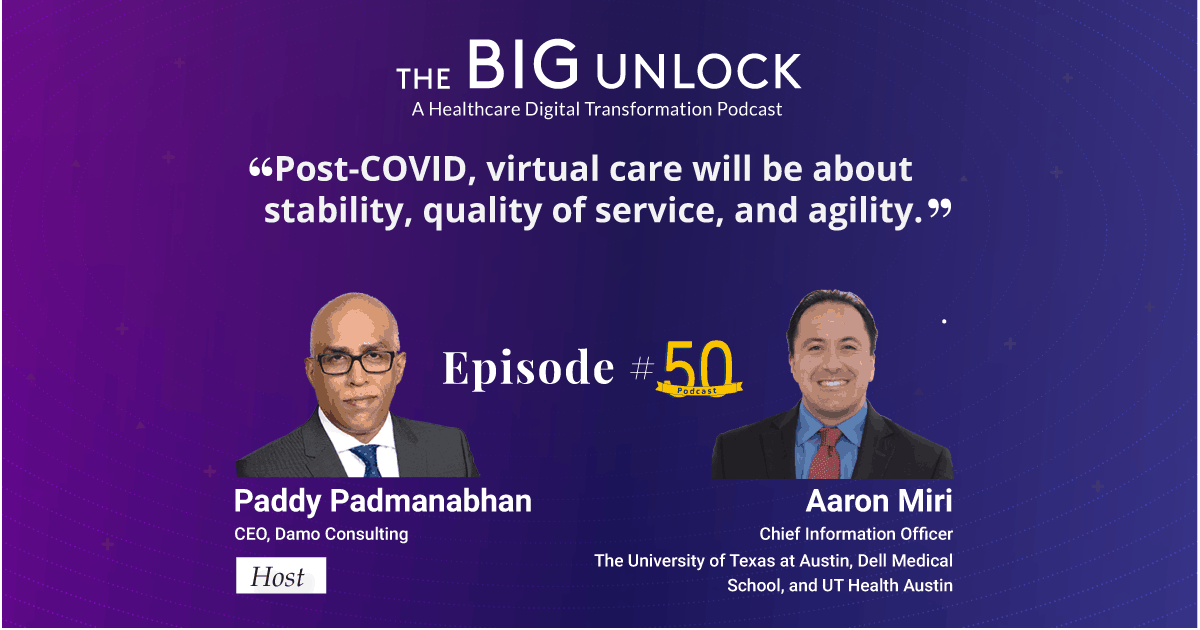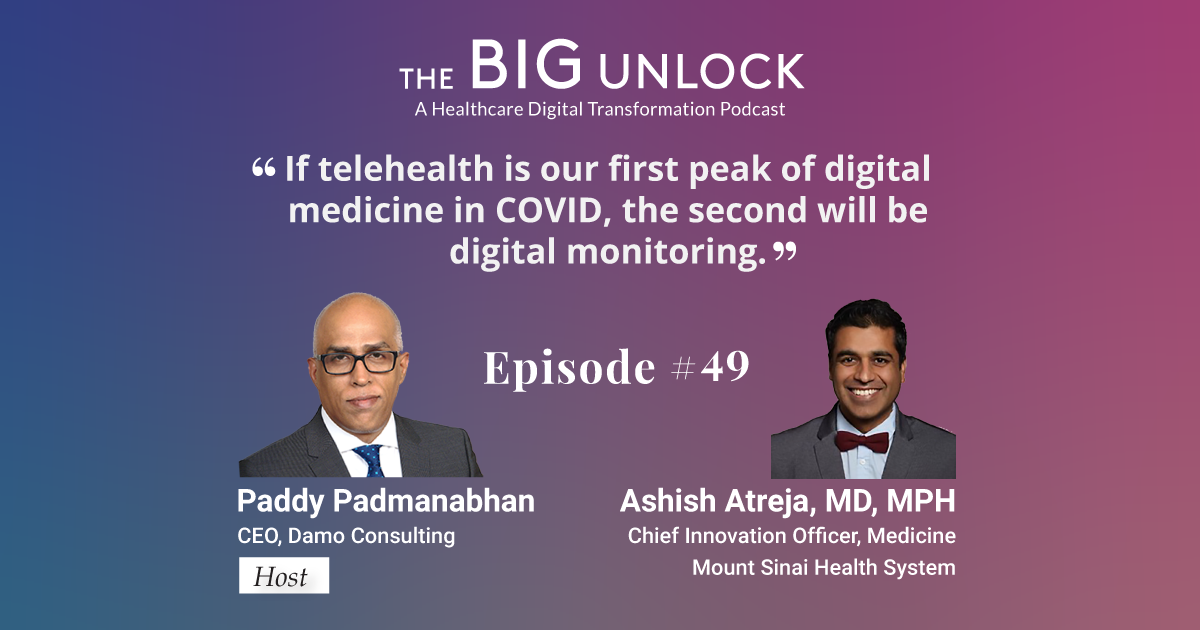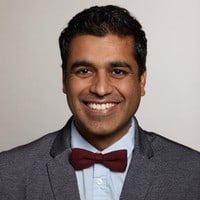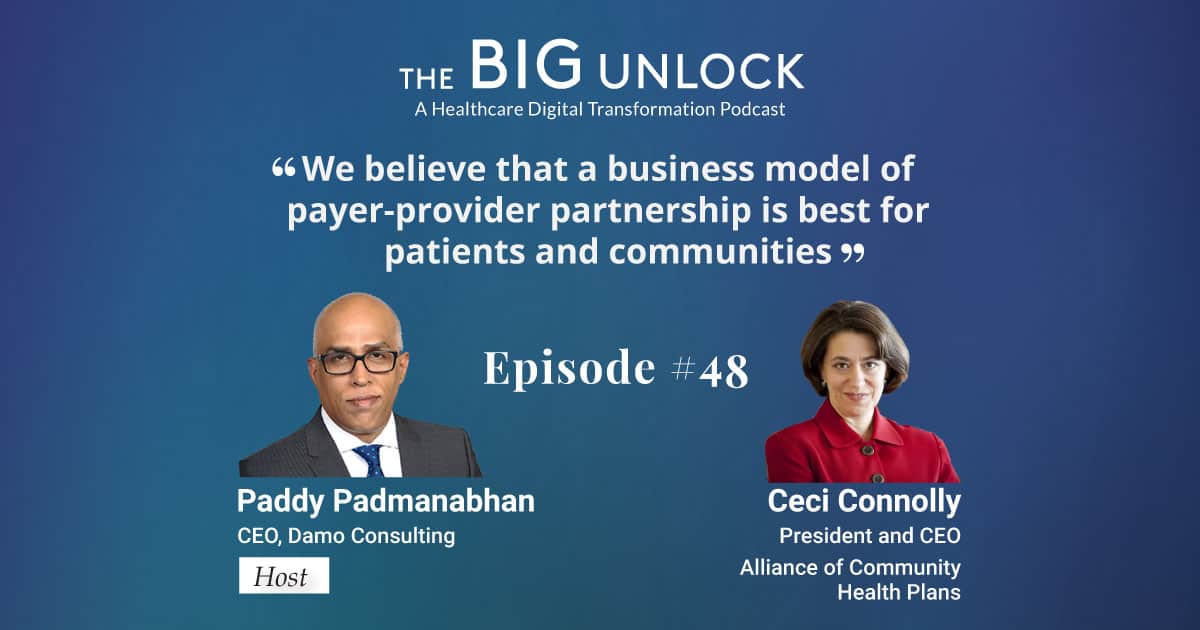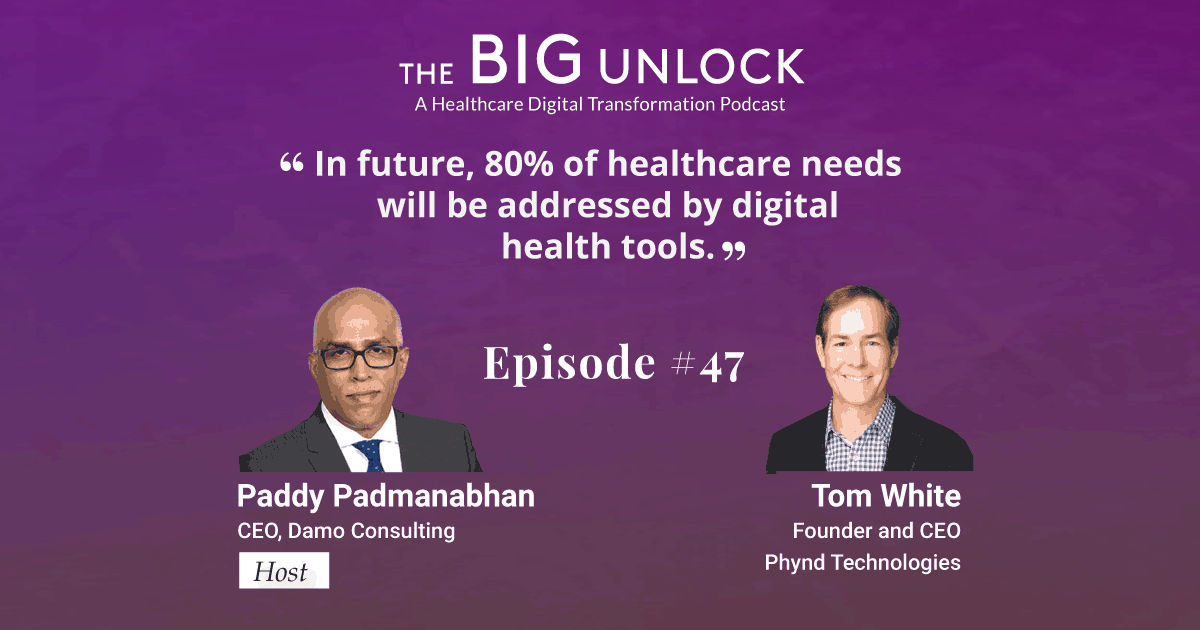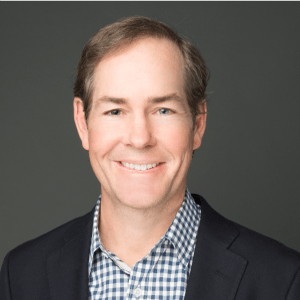Podcast with Aaron Miri
Chief Information Officer
The University of Texas at Austin, Dell Medical School, and UT Health Austin
"Post-COVID, virtual care will be about stability, quality of service, and agility."
 Hosted by Paddy Padmanabhan
Hosted by Paddy Padmanabhan 
Share
In this landmark 50th episode of our podcast, Aaron Miri discusses contact tracing and UT Health’s contribution to prevent the spread of COVID-19 through their public-private partnership with city of Austin, TX.
Austin Public Health has partnered with Dell Medical School and UT Health Austin to prevent the spread of COVID-19 by doing contact tracing on behalf of the city of Austin. Besides contact tracing, the University is also using emerging forms of healthcare delivery such as symptom checking, COVID-19 drive-through testing stations, home monitoring, and nurse triage to control the spread of the current pandemic. Currently, the medical school has over 200 contact tracers working remotely and have successfully performed one-third of the contact tracing in the city of Austin.
Due to the current COVID situation, healthcare consumers are adopting virtual care technologies that are changing the way healthcare is being delivered today. To ensure smooth delivery of care post-COVID, Aaron discusses how virtual care should be a flawless experience for clinicians and patients.
On data interoperability, Aaron suggests three major areas of focus: Identifying and capturing data for public health; the need for the entire continuum of care to be on some sort of a digital system. According to Aaron, healthcare organizations need full data transparency, governance, and internal communication working together to advance interoperability. Take a listen.
Aaron Miri, Chief Information Officer, The University of Texas at Austin, Dell Medical School, and UT Health Austin in conversation with Paddy Padmanabhan, CEO of Damo Consulting on the Big Unlock Podcast – “Post-COVID, virtual care will be about stability, quality of service, and agility.”
PP: Hello again, everyone, and welcome back to my podcast! This is a special episode, our fiftieth episode of The Big Unlock podcast. It is a real privilege and honor for me to have as my special guest today, Aaron Miri, CIO of the University of Texas at Austin, Dell Medical Center. I am really thrilled to have him join us. Aaron, thank you so much for setting aside the time and welcome to the show.
AM: Thank you very much. Congrats on your fiftieth episode!
PP: Thank you very much. For the benefit of our listeners please tell us a little bit about UT Health Austin and the Dell Medical School and the focus areas for your institution.
AM: UT Health Austin is one of the top global universities in the world. About five or six years ago we decided that we really needed our own medical school, our own teaching institute, our own clinical enterprise, and really help Austin and Travis County in the state of Texas out by bringing out some of the world’s best physicians through Austin. Our goal here has been, number one, first and foremost, putting out the best medical students possible, prepare them to enter residency. Number two, having a clinical practice really grounded around value-based care in the principles of community and community impact. And three, what UT Health Austin is known best for, which is research. How do we do some game-changing research in genomics and sequencing and really take it to the next level? So, it is that every aspect of an academic health care delivery network that you could possibly imagine and then some. And then now, you throw in COVID into the whole situation and it grows even more so.
PP: I know you are a thought leader and you’ve written and spoken extensively about advanced technologies and digital transformation in healthcare. And you are a practitioner of all the same principles in your institution. I want to start by asking you about the acceleration of digital transformation in light of COVID-19. We are seeing that healthcare is going virtual – telehealth and all other forms of virtual care, digital front doors and so on. What are you seeing in your conversations with your peers across the healthcare industry as the high priority initiatives for digital consumer engagement in a post-COVID-19 scenario?
AM: A couple of things. Number one, if you look at it from the CIO’s perspective, it is ensuring smooth delivery of service. So, all the way from the clinician experience, the patient experience, and the entire continuity of care virtually should be flawless. So that there are no hiccups in terms of workflow, orders, medical record, what not. Telehealth experience has been one that we continuously refine, even though now our practice is that majority of it is telehealth, although we’re slowly up ticking the in-person again. So, to the degree of it has been about stability, quality of service, execution, agility. There are new workflows.
I mentioned earlier that we are big believers in value-based care. That’s a team-based approach. So, how do you use a virtual lobby to be able to do a pre-staging of a virtual care team, where you have a social worker, a musculoskeletal worker, and a pain management worker altogether visiting. And then, they are able to meet with the patient as a team. Those kinds of virtual workflows we have been innovating because we are not going to stop our principles, which is, we believe, cohort and value-based care. So that’s from a CIO perspective, making sure that your health systems are able to make that leap and suddenly go from in persons up in the dozens to over the virtual telemedicine into the hundreds, if not thousands of sessions daily. So, you have that component.
From a policy perspective, what we’re seeing is this question mark from the CMS. We even saw last week with Seema Verma stating publicly that it’s her intent or her desire to want to leave a lot of the statutes in place that reimburse at even parity level. So I think as that decision comes out, it’s going to obviously affect the landscape, because if they’re not paying and reimbursing at a level that’s sustainable, our health systems will have to make some tough decisions. Most of my peers I’m speaking with are trying to keep the lights on, making sure that they are able to shake and bake to whatever the requests are coming in and ensuring that their staff, be at their remote or in person, are feeling secure and safe and what not. And so, we’re able to deliver medicine remotely without an issue.
PP: In terms of virtual care, in a post-COVID-19 context, some of the things that I’m seeing through our work in my firm is the emergence of newer forms of healthcare delivery. And a couple that come to mind immediately are contact tracing as an example, and COVID-19 apps in general. Of course, it’s kind of hard to unpack what a COVID-19 app means when there are so many technology providers out there saying they have a COVID-19 app. But then contact tracing is something that is a little more tangible. Could you unpack these things a little bit?What should one be thinking when somebody comes up and says,I have got a COVID-19 app that I can help or a contact tracing app that can help you? How are you going about it?
AM: Let’s talk in generalities now, talking specifically about what we’re doing here with UTH Austin. So in generalities, when I mentioned a COVID-19 app, I applaud the vendor community for trying to pivot, especially a lot of startups out there and say how can we apply our platform, our tech, our algorithms towards something related to COVID-19. The majority of the market seems to be leaning towards temperature indicators, whether your home monitoring for temperature checking, whether you are able to baseline an individual based on questionnaires to say, are you potentially symptomatic. Because you were out on Memorial Day weekend on a lake without a mask around 10000 people and probably at a high-risk to catch COVID-19. A lot of what you are seeing on the market are symptom checkers, home monitoring type platforms, algorithms. I have seen RTLS vendors make a pivot towards trying to say, hey, our Wi-Fi, our TLS system can now track your patients that are positive – where they are and ensure that they are maintaining quarantine procedures, that sort of thing.
What we did here at UT Health Austin is a couple of things. Number one, Austin Public Health asked us to partner with them formally and via that delegation of the public health authority, we were able to do contact tracing on behalf of the city of Austin. So, we stood up an app that does that. We have over 200 or so contact tracers all working remotely, calling into a central call center, and accessing this app that we partnered with a startup based out of Seattle to deploy quickly and robustly. These contact tracers are able to enter any information, such as, where was Aaron? Did Aaron go to the barber? Who was at the barber? Let’s call them. Are they symptomatic, that whole lineage of contact tracing?
Believe it or not, Paddy, contact tracing has been done for quite some time with numerous disease states. COVID is not new but this is the first major disease state I’ve seen a public drive towards. How can we digitize contact tracing? And it’s difficult because the CDC is constantly evolving their data sheets based on what they learn. Obviously, more that we learn from the disease, the more types of data they want, and specificity collected. So, we are constantly having to evolve the product that we put on the market here to help. But I just read some stat last week that we’ve successfully done one third of all the contact tracing for the city of Austin. If you think about the 11th largest city in the country, that’s pretty darn impressive. We did this here at UT Austin on behalf of the city of Austin. So, to the degree that there’s a number of components that go into this, but overall, I’d say from our position here, what we’re doing is number one symptom checking. Number two, we have our drive through COVID-19 testing stations. Number three, we’re doing contact tracing, as I mentioned. Number four, we are doing home monitoring. We’re also doing nurse triage, because a contact could quickly say, hey, I have symptoms, I can’t breathe. We need to triage them so we can escalate into that triage and then immediately either enrolling in-home monitoring if it’s manageable or ask them to be present at the emergency department as soon as possible. So, we’ve been phenomenal at getting in front of this and really wrapping our arms around it and taking it very seriously in partnership with the city because UT Austin has those kinds of resources to bring to practice.
PP: You make a very important point in your comments, which is this emerging public-private partnership, public health agencies partnering either at a state, local, or federal level with the private sector. And we’ve seen some efforts to do that at a national level like Google and Apple have gotten together to develop this API, which they’re making available to the federal health agencies at the national level. Then we’ve seen state-level or city level initiatives where public-private partnerships are getting a handle on this whole contact tracing and controlling the spread of infections. What are the one or two things that are truly important for this kind of a public-private partnership to work effectively to ensure that there is public safety, ensure that there is accuracy in all of the testing and tracing and everything that goes on and that at the end of the day, the desired outcomes are met? What are the one or two things that came out of your experience?
AM: I would say these are the top three things for anybody navigating these hurdles. Number one, full transparency, i.e., partnership at a fundamental level of what are you doing, how are you doing. What are our shared objectives? What are our shared populations that we’re going to focus on? Case in point, UT Austin is really focused on indigent care for the city of Austin, which has been fascinating to learn about. So, making sure that there is transparency, there’s constant communication between myself and my counterpart with the city of Austin, the CIO for the city of Austin, who’s excellent. Our data teams are constantly talking to make sure that the data is being shared appropriately, securely, and that there, again, is full transparency on dashboards that we’re building. And so, the data that we’re putting out and that they ultimately published for the public has validity. That there is data provenance behind it. A lineage that anybody can say – how do you know how many tests you’ve given? So those kinds of things are very important because that’s what takes transparency.
Number two is governance. Making sure that just because somebody wants something doesn’t mean that your two teams and two organizations go out and just do it right. It’s got to have a benefit objective and particularly when you’re dealing with public health, you have to have a hyper-focus on ensuring that these are the objectives laid out by the mayor, by the governor or whatever else as appropriate.
Last but not the least, is internal communication. What has happened with COVID is you have a number of practitioners that are logged in from home using Zoom or whatever. So, we are communicating and having standups routinely with them to understand what the shifting landscapes are, what’s going on here in Austin, and the experience of COVID positive patients walking through the emergency department. Are there new protocols, are there new surveillance problems to stand up based on comorbidity? Is there different demographic that we need to be able to focus on a little differently? We had a discussion this morning on how to if we needed to start monitoring neonates, what would we do? How would we handle that issue? We’re trying to get in front of potential questions that come up.
So those are the kinds of things you need to be doing. There really is that hand-in-hand approach and that there is no one institution blazing down a trail inadvertently because of a lack of communication.
PP: What has been your experience with regards to false positives and false negatives in your application and your program with the city of Austin?
AM: I think the false positives, and what not really stemmed from the types of testing that are available, whether it’s serological, whether it’s swab, whether it’s saliva, and all of those components, I think that the general public is learning more about the accuracy of those various COVID-19 tests. Subsequently, if we get the data back from the lab saying – Aaron is COVID positive, but it was a saliva swab. Looking at the level of validity around that, it has downstream effects. So, as the general public learns more, we’re learning just as fast along with them because we can now have more experience. The world has more experience with COVID-19, and so the CDC modifies their approach on a lot of things as to what’s going to happen there, which affects our day to day planning. But that is really where the rub is then, and it’s not around contact tracing or issues with that. I’m actually impressed with the general public’s willingness to partner. I would say the consensus of folks out there, if you call them and say, hey, Aaron, you may have been exposed when you went to the grocery store over the weekend. Do you recall who you’ve been around the past 48 hours? We haven’t had people like, who would spat out and say, you’re invading my privacy. Generally speaking, people want to help, and people want a partner, and people want to do the right thing. So that’s been really positive.
PP: You mentioned the public’s cooperation in these programs, which is extremely critical for you to get a handle on the spread of the infections. In general, when you talk about virtual care models, going back to the earlier comment that you gave us about digital transformation initiatives, virtualization of care, telehealth models. What are you seeing as the public’s acceptance of those kinds of care delivery modalities, if you will? Are they comfortable with it? Are they happy with it or are they just tolerating it in the short term because there’s no other option? What are you seeing with your population?
AM: What’s important is to understand the population you are trying to serve. So, let me give you a few examples here. One of the populations we take care of, beyond obviously the commercial population, is indigent care, disconnected is another terminology I have heard, using an epidemiology sense. People that maybe do not have access to a smartphone or a stable home or resources to care, they may be live in a food desert. All those social determinants of health type issues. So, we have really had to spend a lot of time to understand that population of the kinds of modalities they do want to engage with. Specific to Austin what we have noticed a few things. Number one, most of the indigent population, English is a second language for them. So how do we put apps in front of them that they feel more comfortable engaging with? In our case, it is predominately Hispanic speaking individuals.
So, we put out a Spanish version of the apps. There is an iOS app, also in Spanish, there is an Android app, also in Spanish. And a responsive web form that’s also in Spanish. This is where they can upload their own contacts, they can do their own home monitoring, they can engage the app. The app lets us know who they’ve talked to, all these kinds of dynamics, which are very important when looking at contact tracing. And then, of course, consent. We spend a lot of time getting consent from people. And that’s explicit consent. So you understand that you were sharing with me, your family members at home and who was around you, and you’re consenting to tell me that you’re giving me permission to go ask those questions on your behalf. I never want people to feel like even though this is a public health crisis, they don’t know what’s going on. And those components of, again, transparency and putting applications of tech in front of people they understand and seeking first to understand have been the acceptance criteria over the general public. And we see most people, because we’re taking the time upfront to do these things, are natural to them. We’re not forcing them to jump through hoops or we’re not forcing them to have to not understand, but yet still share information. People want to help. We have not seen that pushback. So those are important components to understand.
Something I found interesting about the population, a data fact for people out there building apps, is that a lot of the indigent care actually do have a smart device of some sort. They’re just disconnected from the app store. They don’t have a way to download an iOS app or an Android app. Or they don’t have a data plan. They just simply go free Wi-Fi to free Wi-Fi as they walk around the city. So, it is interesting, the other types of connected behavior that we’re seeing, and I think there’s an entire ecosystem at some point that needs to get in front of this. Perhaps this is what you could do now with Elon Musk’s Starlink. He’s putting up with the ubiquitous coverage of Wi-Fi. Those kinds of industries are going to crop up to help connect the disconnected.
PP: We’re doing some work with some health system in New York City. Of course, the population is very similar to what you’re describing, indigent population, but a diverse, ethnically and linguistically. You mentioned the need for multilingual apps, and then you also mentioned that everybody has a smartphone, but they don’t necessarily have access to the app store because they live in either bandwidth deserts or they just cannot afford it or for whatever reason. And so, a related concern that seems to be arising is the notion of inequalities in access to healthcare by virtue of these inequalities in access to bandwidth as an example. Hopefully, all of that will be addressed through initiatives like the one you just talked about, where you’re giving people access to bandwidth so that they can go and download their apps. The apps that they need or being prescribed to them by their physician and so on.
AM: That’s right. And I would also say one more thing is that we have phenomenal teams of clinicians, family medicine docs that are helping us to do all of this. So, they encountered somebody, say, in a food desert. They’ll also set them up with a connection back to local and state resources that help identify may be meals on wheels. Other programs out there that maybe they didn’t have access to or even know about. So, you can use your COVID-19 programs to help populations of people beyond COVID. In our case, we’re giving them resources and access to state resources that they didn’t know existed and say, look, you don’t need to sit there in hunger, or you don’t have electricity. There are ways we can help you navigate these things. It just takes a focus on public health and it takes your team caring, and I’m very proud of the UT Austin team.
PP: Everyone I’ve talked to have come a long way in the last few months. In March, we really didn’t know what hit us and we had to scramble to get things in place. So, that we’re going to take care of the infected population and at the same time make sure that our regular population doesn’t deteriorate in their conditions and so on. I’m going to come to that in a minute. But it also seems to me like over the three or four months, a tremendous amount of knowledge sharing has happened and people are learning from each other’s experiences and really come a long way in terms of understanding how to address a situation like this in future. We’re a long way away from the current crisis itself. We don’t have a vaccine yet and so many other things, but it seems like we’re much more informed today. What has been the kind of collaboration among your peer groups, across your peers, CIOs in other health systems who are doing similar things? Do you have a forum platform where you share ideas, best practices?
AM: There’s been a couple of things. Number one, across all of the UT system – these include all the CIOs of UT South-Western, M.D. Anderson, myself, others – we are all constantly collaborating on what our institutions are doing across the state to take care of Texans and things that we’re learning, whether it’s data, whether it’s processes, whether it’s how do you set up thermal imaging cameras the whole nine yards across. Across CHIME there are numerous discussion boards and information sharing forums where CIOs are talking, there’s a group of about 40 of us that converse via email asking general questions, asking how do you return to work? Thermal camera discussion, like I mentioned, data, data provenance issues, all sorts of things.
At a federal level, I also am a congressionally appointed member of the HITECH. There has been some phenomenal data and idea-sharing exchanges between the CMS, which would just cross all of HHS, and with the payer side and the provider side to understand what is happening boots on the ground and they make modifications. I recall very vividly there was a couple of emergency discussions with HITECH in March and April in which I was very vocal. In couple of Modern Healthcare articles where I stated pretty emphatically that CMS and others needed to help us, they needed to help us immediately. Our cellular lines are getting overrun, there were all kinds of issues. If you recall that timeframe, people thought what was happening in New York was about to happen across the country. And to the credit of HHS, they mobilized.
Whether it’s helping to make sure that data was more quickly, readily available, and normalized, whether it was making sure that CMS was relaxing telemedicine rules as fast as possible. I’m not saying that the HITECH meeting made that all happen. I am saying the right people were listening and they committed to changing it. So, I give a lot of credit to the administration for listening and for making changes that really benefited boots on the ground. So those are the kinds of things that are happening. It is not happening in isolation where you’re sitting at a hospital and you don’t know who to talk to. The whole healthcare community has rallied together to really get behind this. And I haven’t found one person unwilling to help or dive in or lend a hand if you need it.
PP: Yeah, in a way, the pandemic has accelerated the future. And that’s kind of what Ed Marx, my co-author for our upcoming book on Healthcare Digital Transformation pointed out, which is that consumerism and technology are already changing the way healthcare is being delivered and being accessed and experienced. The pandemic has accelerated all of that and by an order of magnitude is what it seems like. Would you agree with that?
AM: I would agree with that. I would also say that consumerization has always been here. The problem with healthcare is that it’s an industry that has always been focused on reimbursement first. And that’s from the early days when Medicare and Medicaid first came out in the mid-60s. That has just become the focus of how do you submit claims for payer reimbursement? And so, because we thought that telemedicine was never reimbursed at a parody level or whatever, that there was never going to be mass adoption, and yet the consumers actually want it. I will give you a specific example. We do net promoter score – scoring for all of our patient encounters on top of age caps and all other things you have to do. We want to know in real-time -How was your experience? Would you recommend a friend? Then, tell us something, in free text form, about your experience that we should know. You usually get the whole, “Aw! Traffic is abysmal on Austin or parking was hard in a garage.”
OK! I’m (Austin) a city. I can’t change the traffic situation. Austin, Texas. I wish I could write for beyond healthcare purposes. However, our NPS was always in the 80s, which is really good looking at the net promoter score. However, since we’ve gone to telemedicine, our net promoter score is now in the 90s. People don’t have to put up with those headaches of traffic and parking anymore. So, consumerization has always been a desire. The problem is the healthcare industry just wasn’t going fast enough for what the general public wants. And so, my hope is now this COVID, as bad as it is, has highlighted the fact that you can be thought blazing with health care and people will adapt to it. They’re not stuck in the 1980s. They want to engage with you via a face time, communication or whatever. They want that. I want that right. I don’t want to drive unless I absolutely have to.
PP: Another topic, the whole notion of data interoperability and how we are set up today versus how we need to be set up for the future. You mentioned CMS finalizing interoperability ruling back in March. And so, we’re going to hopefully see an improvement in data interoperability and all the information blocking practices. But having said all that, the way data is structured today within our primary repository, a system of record, which is the electronic health record. The pandemic has exposed some serious limitations, and this is what I hear everywhere I go. What are your thoughts on that? What should we be doing now from data interoperability and just data management standpoint, knowing that we have what we have, which is a current electronic health record landscape, but our needs are now evolving very, very quickly?
AM: So, without getting overly technical and starting to talk about standards and other formatting and data issues, I will talk about the generalities. Number one, we are still learning about COVID, particularly in public health. We’re still learning what data elements we need to track. This is why the recent issues cropped up about race and ethnicity. And gaps of care, because not everybody mandates those fields to be filled out or we are not capturing it accurately. So, I would say, number one is we need to get a general baseline field for public health criteria. What are the standards that need to be tracked every single time? Is it race and ethnicity and of course, age and comorbidities? What is it? We had the same issue with Zika a few years ago with pregnancy. We weren’t able to track people who were pregnant because pregnancy status at that time was not mandatory. Now it is a required field. So, there are these things we need to learn. I would say, number one, a general baseline of definitions and data capture for public health that everybody must adhere to, rights that standards formation and you could put it through the USCDI process that was developed into 21st Century Cures Act that we did in the HITECH so that we can adopt those criteria.
Number two, I would say that we need to make sure that we do not forget other types of care across the care continuum. Right now, rehab, nursing homes, SNFs, they all need to be on some sort of digital system. They are not, obviously, with the American Recovery and Reinvestment Act of money was allocated towards digitizing the inpatient and acute care market. Not a bad thing. That is where people are the sickest. I totally get it. But we have to go back and make sure those care locations are just as digital and just as regulated as the inpatient facilities are. So, we have a continuum of discrete data.
And number three, a better partnership between public health and private sector. Again, I’m blessed here to be with Austin and UT Austin, which have a great relationship. I do not think the same exists in every locale, in every city. So how do you reboot and have those types of didactic discussions so that in the event of a pandemic, in the case of COVID 19, there’ll be future COVIDs. How do we make sure that those tenants we spoke about earlier are in place of transparency and governance and communication? You’ve got to have all those components working together. It’s not just standards, but that’s how we’re going to advance interoperability. I do think that 21st Century Cures Act, that is the law, as you just mentioned, was finalized, I believe it was beginning in March, should help. But we still have a long way to go because just because I put the tool in front of you doesn’t mean it’s going to be used appropriately.
PP: Well Aaron, we’re coming up to the end of our time here. I had just one last question related to the innovation ecosystem and their role in driving healthcare forward, especially from a digital transformation standpoint. And I know that as part of CHIME, you are also launching a series of webinars related to digital health innovation. What are you trying to address there? What are you seeing in the marketplace and what are you trying to address with this new series? What’s the expectation?
AM: I am a big believer in partnering especially with startups and young companies, on how do you and in a very agile manner, deal with a problem that you’re facing, whether it’s COVID related or not. There are companies out there that are hungry to want to innovate with you, and not that the large companies are bad. We have great partnerships with major companies here, too, at UT Austin. But it’s sometimes a lot easier to partner with a startup and solve a problem. And so, this innovative series that CHIME has started is around that. How do CIOs partner with a startup, a young startup to solve a specific problem? And the session that we have coming up is specific around contact tracing and home monitoring and the whole issue of COVID I just spoke about. When we were faced with this in March, the request comes to you as a CIO. Hey, what do you do for home monitoring on patients? What do we get? How do we build it? Do we build it in Redcap? Do we build an app ourselves? Hey, we need to do contact tracing. We don’t want to do it in Excel. Do we want to build an access database and do some crazy requests? You get like stop. Right. I can do the same old thing over and over again and not really advance the problem. Or I can partner with someone and really knock us out of the world and really benefit the society as a whole, which is the route we went. That’s what this series is about, its about thinking different, stepping outside your comfort zone and feeling OK to break a few rules, because it’s at the end of the day, you have a much more robust delivery of care and care processes. Also, your physicians are a lot happier and your patients, too.
PP: We never really got to talk about remote monitoring, and that’s a whole different maybe another podcast sometime in the next few weeks. Thank you so much for joining us and I look forward to participating in these webinars that you’re doing with CHIME. That is going to be very interesting for those who are listening. I would strongly recommend it. It’s got Aaron moderating them, so it’s got to be an interesting discussion. Well, Aaron, thank you again for joining us and I look forward to being in touch.
AM: I appreciate very much. Thanks, Paddy.
We hope you enjoyed this podcast. Subscribe to our podcast series at www.thebigunlock.com and write to us at info@thebigunlock.com
Disclaimer: This Q&A has been derived from the podcast transcript and has been edited for readability and clarity
.
About our guest
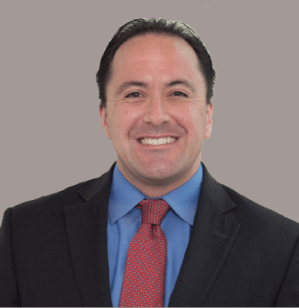
Aaron Miri is the Chief Information Officer for The University of Texas at Austin, Dell Medical School and UT Health Austin. He brings more than a decade of healthcare experience driving growth and innovation, leading both provider and commercial healthcare enterprises, and providing thought leadership and close collaboration with state and federal representatives. As the CIO, Aaron is passionate about humanizing technology by collaborating with clinicians, technology partners, and business champions to truly transform healthcare delivery for consumers, patients, and providers.
In 2018, Aaron was congressionally appointed to the Health and Human Services, federal Health IT Advisory Committee (HITAC), established under the 21st Century Cures Act. Previously, Aaron was federally appointed by HHS Secretary Sylvia Burwell to serve on the HHS Health IT Policy Committee established under the American Recovery and Reinvestment Act of 2009. He is the prior Chair of
the HIMSS National Public Policy Committee and serves as an expert adviser to the United States Senate Committee on Health, Education, Labor, and Pensions (HELP) and to other congressional panels engaged in numerous Health IT policy topics. Aaron also serves as an advisor to the National Academy of Medicine on the topics of healthcare privacy, secure, and data.
Aaron is a well-known international thought leader and he brings a deep understanding of how to leverage digital health and the latest technology to accelerate healthcare delivery across the continuum of care. Prior to joining U.T., he served as the Chief Information Officer for Imprivata, the Healthcare IT security leader, where he helped to build and transform a global commercial enterprise focused on healthcare cyber security. Prior to Imprivata, Aaron was the Chief Information Officer for Walnut Hill Medical Center, lauded by Forbes Magazine as the hospital that Steve Jobs would have built. He has successfully led organizations that achieved the HIMSS Nicholas E. Davies Award, HIMSS Level 6 and HIMSS Level 7 EMRAM status, HITRUST CSF designation, and led the first provider organization to receive the SECURETexas Health Information Privacy and Security certification awarded through the Texas Health Services Authority (THSA). Aaron is also a proud member of the CHIME CIO Boot Camp Faculty and routinely mentors’ early careerists through CHIME, HIMSS and other national associations.
Aaron received his MBA, with honors, from the University of Dallas, and his Bachelor of Science in Management Information Systems from the University of Texas at Arlington. Aaron is a Certified Healthcare Chief Information Officer (CHCIO) through the College of Healthcare Information Management Executives (CHIME), a distinguished Fellow with the Health Information Management Systems Society (HIMSS), and he is a Project Management Professional (PMP) with the Project Management Institute (PMI). Aaron is a nationally recognized 2020 “CIOs to Know” by Beckers Hospital Review and was honored with the 2016 Computerworld Premier 100 Technology Leaders award, 2017 Texas Health IT Leadership Award, and the 2019 Constellation Research Business Transformation 150 award. He serves as a board member in the not-for-profit Cartwheel Health, serves as a CIO board advisor for Dell Inc., and as an advisor for numerous healthcare startups and leading venture capital corporations.
Recent Episodes
About the host
Paddy is the co-author of Healthcare Digital Transformation – How Consumerism, Technology and Pandemic are Accelerating the Future (Taylor & Francis, Aug 2020), along with Edward W. Marx. Paddy is also the author of the best-selling book The Big Unlock – Harnessing Data and Growing Digital Health Businesses in a Value-based Care Era (Archway Publishing, 2017). He is the host of the highly subscribed The Big Unlock podcast on digital transformation in healthcare featuring C-level executives from the healthcare and technology sectors. He is widely published and has a by-lined column in CIO Magazine and other respected industry publications.
